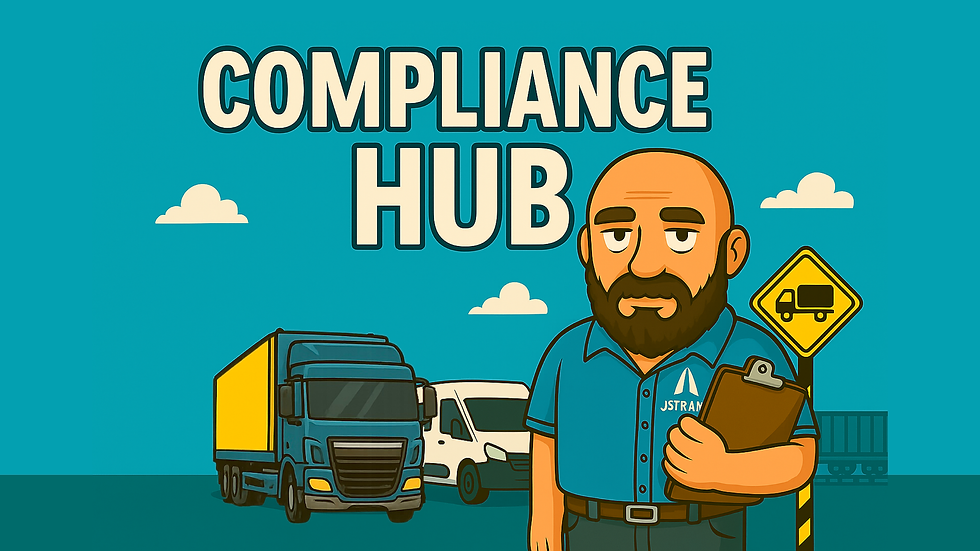Building a Bulletproof Compliance File: What to Keep and Why
- stuart47304
- Jul 8, 2025
- 4 min read

If the DVSA or Traffic Commissioner knocked on your door today and asked to see your compliance records, would you be ready?
For many Restricted Operator Licence holders, compliance feels like a moving target. You know you need to keep “the right records,” but no one hands you a ready-made checklist — until now.
This guide will help you build a bulletproof compliance file — the kind that shows you take your operator responsibilities seriously and can stand up to scrutiny.
We'll cover:
Why a compliance file matters
What documents to include
How long to keep each type
Paper vs. digital systems
Tips for staying organised
How to show evidence proactively
Why Build a Compliance File?
A compliance file is your defence — and your proof — that you’ve taken every reasonable step to operate legally and safely.
It helps you:
✅ Respond quickly to DVSA audits or spot checks
✅ Prepare for Public Inquiries
✅ Train and manage drivers
✅ Avoid enforcement action or licence revocation
✅ Sleep better at night knowing you’re on top of things
In short, it’s your paper trail of professionalism.
What Should Be in a Compliance File?
Here’s a breakdown of essential documents to include — grouped into logical sections:
📁 1. Operator Licence and General Details
Copy of your Operator Licence (front and back)
Licence undertakings (signed)
DVSA correspondence
Evidence of Operating Centre permission (e.g. lease, letter)
Planning consent (if applicable)
Contact details for your maintenance provider
Company structure and key contacts
📁 2. Vehicle Maintenance
For each vehicle in your fleet:
Safety inspection planner (12-month rolling schedule)
PMI (Preventive Maintenance Inspection) reports — last 15 months
Repair and service invoices
MOT certificates and failure/retest records
Brake test reports
VOSA/DVSA inspection sheets
Wheel torque tightening records (if applicable)
Roadside defect rectification evidence
Vehicle disposal or purchase paperwork
📁 3. Defect Reporting & Daily Walkaround Checks
Blank walkaround check sheets or app screenshots
Completed defect reports (15 months retention)
Rectification logs signed by maintenance provider
Driver defect training or briefing records
Internal process (policy) for defect reporting
📁 4. Tachograph & Driver Hours Compliance (if in-scope)
Copy of tachograph calibration certificates
Driver card and vehicle unit download logs
Infringement reports and sign-offs
Training records for tacho use
Records of weekly rest, daily driving hours, and breaks
Exemption policy (if operating under GB domestic rules)
Duty logs (for exempt vehicles)
📁 5. Driver Management & Conduct
For each driver, keep:
DVLA driving licence copy
Licence check logs (every 3–6 months)
Evidence of entitlement to drive relevant category
Medical declarations (if applicable)
Training records (e.g. hours rules, defect checks, load safety)
Incident or disciplinary records
Employment or engagement contract (if relevant)
📁 6. Operating Centre Information
Approved site documentation (e.g. from licence application)
Planning approval or evidence of exemption
Site plan or photos
Complaints log (if applicable)
Noise management or traffic mitigation policies
📁 7. Financial Standing Evidence
Last 3–6 months’ bank statements
Overdraft facility letters (if used to meet standing)
Cash flow forecast or budget plan
Profit & loss summaries (for audits or renewals)
📁 8. Policies & Procedures
Record-Keeping Policy
Maintenance Policy
Driver Defect Reporting Policy
Driver Conduct Policy
Transport Compliance Responsibility Statement
GDPR/data handling statement for driver data
Training policy (even informal guidance)
📁 9. Audit & Internal Review Documents
Internal compliance checklists
Review notes of previous issues and actions taken
Consultant or external audit reports
DVSA reports or inspection outcomes
Public Inquiry paperwork (if any)
How Long Should You Keep Transport Records?
Record Type | Minimum Retention |
Maintenance records | 15 months |
Driver defect reports | 15 months |
Tachograph data | 12 months (driver) / 12 months (vehicle unit) |
Driver hours logs | 12 months |
Driver licence checks | 2 years recommended |
Financial standing documents | 12–24 months |
Training & briefings | 2 years |
Operator licence correspondence | Indefinitely |
Public Inquiry outcomes | Indefinitely |
Tip: Keep backups — cloud storage or scanned copies protect you from loss.
Digital vs. Paper Filing: What’s Best?
Both are accepted — DVSA and the Traffic Commissioner will accept digital files, provided they are:
Complete
Readable
Accessible on request
Paper systems work well for small operators if kept tidy and current.
Many use a hybrid model:
Paper walkaround checks
Digital maintenance planner
Cloud storage for scanned PMIs, invoices, driver checks
Use whatever system you’re more likely to maintain consistently.
How to Organise Your File
Structure your system by:
Driver: All documents per individual
Vehicle: Everything related to a specific reg
Policy areas: Maintenance, licensing, finance, etc.
✅ Use clear folder names
✅ Date-stamp every document
✅ Create an index or checklist at the front
Tips to Keep It Bulletproof
Review monthly — set a calendar reminder
Use checklists to spot missing documents
Keep signed records (especially for training and policies)
Address any gaps in writing — note why something is missing
Train your team (even part-timers) to follow the process
Store backup copies off-site or in cloud storage
How a Good File Helps You
A robust compliance file can:
Protect you in a DVSA audit
Demonstrate good repute to the Traffic Commissioner
Reduce the risk of Public Inquiry
Speed up renewals or site changes
Impress insurance providers and clients
Help you sleep better at night
It’s not about red tape. It’s about proving you're serious about safety and legality.
Conclusion
Your Operator Licence is a legal privilege — and your compliance file is your evidence that you deserve it.
Don’t wait for a roadside stop or a formal request. Build your file now, keep it current, and you’ll be ready for whatever comes your way.
A tidy file could be the difference between a warning and losing your licence.
Next in the series:👉 Compliance Health Check: Is Your Operation at Risk?
